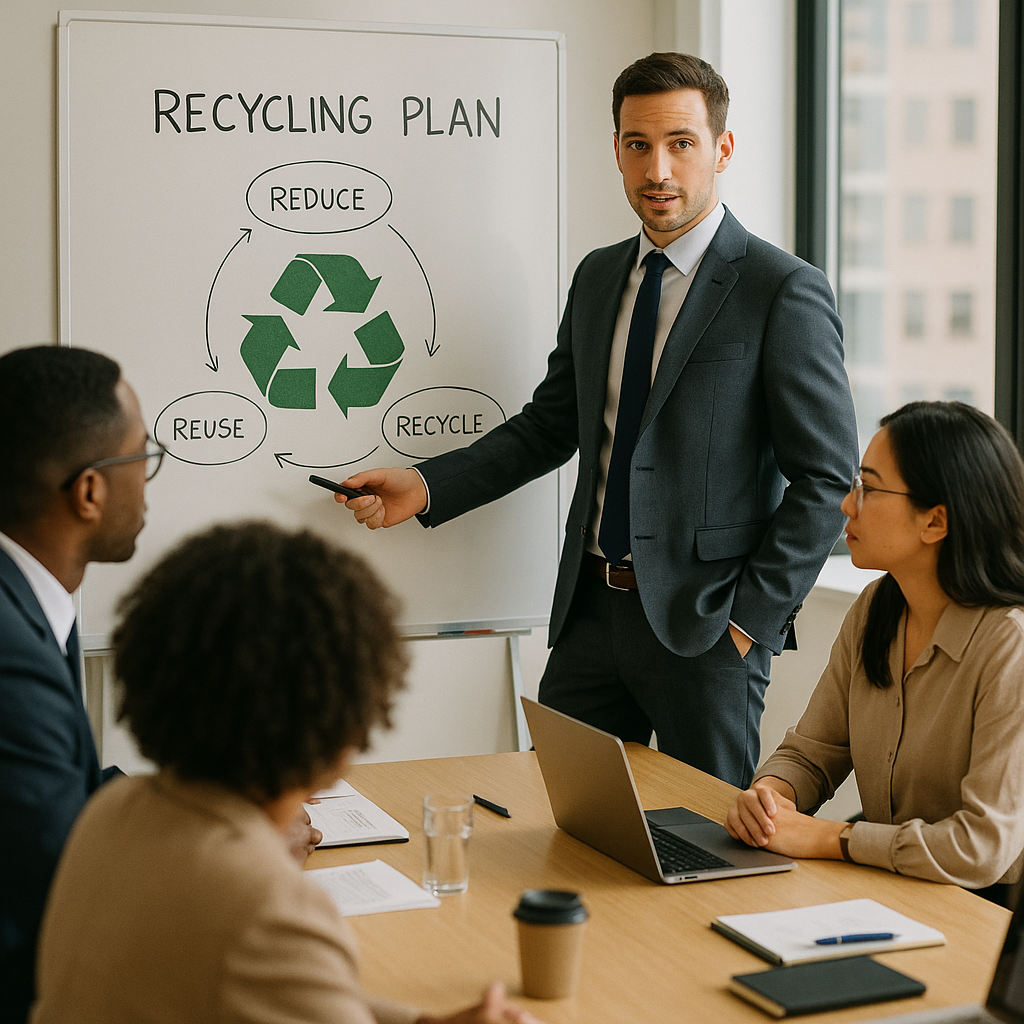5901 Botham Jean Blvd, Dallas, TX 75215
The Importance of Managing Waste on Large Construction Sites
July 21, 2025The construction industry is one of the largest contributors to global waste generation. Nearly one-third of all landfill materials worldwide are from construction and demolition activities. This significant volume not only causes environmental damage but also leads to financial losses for construction companies.
Effective waste management on large construction sites offers multiple benefits beyond environmental protection. Companies that implement proper waste strategies achieve better regulatory compliance, avoiding costly fines and project delays. These practices often result in reduced material costs through reuse and recycling initiatives.
For project managers overseeing large construction sites, waste management directly influences operational efficiency. Clean, organized job sites enhance worker productivity and safety. The challenge lies in developing systematic approaches capable of handling the diverse materials and substantial volumes typical of major construction projects.
What Are the Key Challenges in Managing Waste on Large Construction Sites?

Large construction sites generate huge volumes of waste materials daily. Despite the growing emphasis on sustainability, managing this waste effectively remains challenging. Construction companies encounter various obstacles when implementing waste management systems, ranging from practical logistics to regulatory concerns.
Volume and Complexity of Waste
The sheer quantity of waste produced on large construction sites presents immediate management challenges. These sites generate diverse waste streams that require different handling methods. Concrete, wood, metal, plastics, and potentially hazardous materials all demand specific disposal approaches.
Material complexity further complicates waste management. For instance, concrete and rubble might be recycled as aggregate for new projects, but they require proper separation from other waste types. Similarly, materials like drywall can be recycled but must remain clean and uncontaminated to retain their value.
Construction sites often lack systems to sort materials effectively at the source. When different waste types are mixed together, recycling becomes significantly more difficult, leading much of the material to end up in landfills unnecessarily.
Lack of Standardized Processes
Many construction firms operate without clear waste reduction protocols. This absence of standardized procedures leads to inconsistent practices across projects and missed opportunities for material recovery.
Without proper training, workers often resort to disposing of all materials as general waste. Even well-intentioned staff may struggle to implement effective waste segregation without explicit guidelines. The construction industry’s traditional focus on speed and cost efficiency sometimes overshadows waste management concerns.
Documentation gaps also hinder progress. Without tracking systems to measure waste generation and diversion rates, companies lack the data needed to improve their practices or demonstrate compliance with sustainability requirements.
Site Constraints and Logistics
Space limitations present major challenges on construction sites. Finding adequate room for waste sorting, storage, and collection containers can be difficult, especially in urban environments with limited site boundaries.
Staging areas for waste must compete with material storage, equipment positioning, and active work zones. This competition for space often results in inadequate waste management infrastructure, leading to improper disposal practices.
Logistics coordination adds another layer of complexity. Transporting different waste streams to appropriate facilities requires careful scheduling and coordination with haulers. The timing of waste removal must align with project phases to prevent disruptions to construction workflows.
Regulatory Pressures and Compliance
Construction waste management operates within an increasingly strict regulatory framework. Local, state, and federal regulations govern what materials can be sent where, how they must be handled, and the documentation required.
Navigating these regulations requires specialized knowledge. Requirements can vary significantly between jurisdictions, creating confusion for companies operating across different regions. Regulatory compliance adds administrative burdens through required reporting, tracking, and certification.
Non-compliance risks significant consequences, including project delays, financial penalties, and reputational damage. The potential for hazardous waste violations carries particularly severe penalties, increasing the stakes for proper management.
Resistance to Change
Perhaps the most persistent challenge is overcoming resistance to new waste management practices. Construction has established methods that prioritize speed and convenience over sustainability. Changing these patterns requires a cultural shift within organizations.
Cost perceptions create barriers to implementation. Many construction firms view comprehensive waste management as an added expense rather than a potential source of savings through reduced disposal costs and material recovery. This short-term financial focus overlooks long-term benefits.
Skepticism about process changes can run deep. Workers and managers may question whether new waste procedures will slow production or create additional burdens. Without strong leadership commitment and clear demonstration of benefits, resistance can undermine even well-designed waste management programs.
Education and Training Gaps
Effective waste management requires knowledgeable participants. Many construction workers lack training in proper waste segregation techniques and material identification. Without understanding which materials can be recycled or how to handle potentially hazardous waste, staff default to the simplest option—throwing everything in one container.
Training challenges escalate with project scale. Large construction sites often employ numerous subcontractors, each with its own practices and priorities. Ensuring consistent waste management across all these entities necessitates coordination and educational efforts that many projects fail to prioritize.
Communication barriers further complicate training. Construction sites frequently employ workers with diverse language backgrounds, making clear instruction on waste procedures more difficult without multilingual resources.
| Challenge | Impact |
|---|---|
| Volume and Complexity of Waste | Requires different handling methods; complicates recycling due to mixed materials. |
| Lack of Standardized Processes | Inconsistent practices; missed opportunities for recycling; difficulties in compliance tracking. |
| Site Constraints and Logistics | Limited space for waste management; logistical challenges in transporting waste. |
| Regulatory Pressures and Compliance | Complex regulations; risk of fines and project delays for non-compliance. |
| Resistance to Change | Cultural resistance to new practices; misconceptions about waste management costs. |
| Education and Training Gaps | Insufficient training in waste segregation; diverse worker backgrounds complicate communication. |
How Can Construction Companies Implement Effective Waste Management Plans?

A business manager engages the team by presenting a recycling plan, fostering collaboration in a bright office environment.
Effective waste management begins with a comprehensive plan developed before construction starts. This proactive approach significantly reduces waste generation throughout the project lifecycle. A well-crafted waste management plan helps construction companies save costs, comply with regulations, and minimize environmental impact.
Conduct Pre-Project Waste Audits
Start by analyzing the types and quantities of waste your project will likely generate. This crucial step lays the groundwork for targeted waste reduction strategies. Review project specifications, building materials, and construction methods to identify potential waste streams.
During the audit, categorize expected waste into recyclable, reusable, and landfill materials. Quantify anticipated volumes for each category based on project scope and similar past projects. This data helps set realistic waste reduction targets and allocate appropriate resources for waste management.
Include an assessment of local recycling facilities and waste management services in your audit. Identify partners who can handle specific waste streams and understand their requirements for material acceptance. This knowledge ensures you have viable outlets for diverted materials.
Set Clear Waste Reduction Objectives
Establish specific, measurable targets for waste reduction and recycling. Instead of vague goals, define precise metrics such as reducing overall waste by 20% compared to similar projects or diverting 75% of waste from landfills. These concrete targets provide clear direction and allow for meaningful progress tracking.
Align waste reduction objectives with project timelines, creating milestone targets for different construction phases. Emphasize waste reduction during the design and planning stages, where decisions have the greatest impact on material efficiency. Make objectives challenging yet achievable to maintain team motivation.
Document these objectives formally and communicate them to all project stakeholders. Include waste reduction targets in project documentation and contractor agreements to establish accountability. Regularly reviewing these objectives throughout the project ensures they remain relevant and attainable.
Outline Waste Sorting and Recycling Processes
Develop detailed procedures for on-site waste segregation. Specify locations for different waste containers and establish clear labeling systems. Train workers to recognize which materials go where, making proper sorting intuitive. Consider using color-coded bins to simplify the sorting process.
Create material-specific handling protocols that maximize recycling potential. For concrete and masonry waste, outline crushing and reuse options. For wood, detail sorting requirements that separate treated from untreated materials. For metals, establish collection systems that prevent contamination with other waste types.
Implement a waste tracking system to monitor waste generation and diversion rates. This system should document quantities of materials recycled, reused, and sent to landfills. Regular reporting helps identify areas for improvement and demonstrates compliance with project waste reduction targets.
Assign Team Responsibilities
Designate a waste management coordinator to oversee the implementation of the waste plan. This person serves as the point of contact for waste-related issues and ensures consistent application of waste management practices. Choose someone with knowledge of sustainability practices and good communication skills.
Clearly define waste management responsibilities for all project participants, from site managers to subcontractors. Include waste handling procedures in subcontractor agreements and make compliance mandatory. Regular site inspections by the waste coordinator help ensure everyone follows established protocols.
Establish a communication framework for waste management issues. Schedule regular meetings to discuss challenges and share successful strategies. Create accessible channels for workers to report problems or suggest improvements to waste management practices. This collaborative approach fosters a culture of waste reduction.
Integrate the Plan into Project Timeline
Incorporate waste management activities into the overall project schedule. Allocate time for waste sorting, processing, and removal to prevent accumulation that could impede construction progress. Coordinate waste collection with project milestones to maintain site organization.
Plan for waste management needs at different project phases. Early stages may generate packaging and excess materials, while later phases produce more mixed waste. Adjust container types and collection frequencies to accommodate changing waste streams. This flexibility ensures efficient waste handling throughout the project.
Review and update the waste management plan regularly as the project progresses. Construction plans often change, affecting waste generation patterns. A dynamic waste management plan adapts to these changes while maintaining focus on waste reduction goals. Document revisions to create a reference for future projects.
Monitor and Evaluate Plan Effectiveness
Implement systematic monitoring procedures to track waste management performance. Collect data on waste quantities by type, recycling rates, and disposal costs. Compare actual results against targets to assess plan effectiveness. This quantitative approach provides objective evidence of progress.
Conduct regular site inspections to evaluate compliance with waste management procedures. Look for proper bin usage, material segregation, and general site cleanliness. Address non-compliance issues promptly through additional training or process adjustments. Recognition of good practices encourages continued adherence to waste management protocols.
Document successes and challenges throughout the project. This information creates a valuable knowledge base for future waste management planning. Share positive outcomes with stakeholders to demonstrate the benefits of effective waste management. Use challenges as learning opportunities to refine approaches on subsequent projects.
| Key Challenge | Impact |
|---|---|
| Volume and Complexity of Waste | Complicates handling, requires specific disposal methods |
| Lack of Standardized Processes | Leads to inconsistent practices, missed recovery opportunities |
| Site Constraints and Logistics | Space limitations hinder sorting, competing needs disrupt management |
| Regulatory Pressures | Increased compliance burdens, risk of fines and delays |
| Resistance to Change | Hesitation to adopt sustainable practices, viewed as costly |
| Education and Training Gaps | Insufficient worker knowledge, inconsistent waste handling |
What Innovative Solutions Can Improve Waste Management on Large Job Sites?
Construction and demolition waste pose a significant environmental challenge. The EPA reports that over 600 million tons of construction debris were produced in the United States in 2018 alone. This immense volume highlights the urgent need for innovative waste management solutions on large construction sites. Fortunately, the industry is developing effective methods that not only reduce environmental impact but also enhance operational efficiency and reduce costs.
Digital Tools for Waste Tracking
Advanced technology is reshaping how construction sites monitor and manage waste materials. Digital tracking systems provide real-time data on waste generation, assisting project managers in identifying problem areas and implementing targeted solutions. These platforms centralize information on material usage and waste production, enabling teams to make informed decisions.
Construction management software with waste tracking capabilities allows teams to properly document waste streams, monitor diversion rates, and generate comprehensive reports for regulatory compliance. IoT sensors installed in waste containers can alert teams when bins require collection, optimizing hauling schedules and preventing overflow issues that lead to contamination.
Building Information Modeling (BIM) takes waste prevention a step further by enabling precise material quantification and clash detection before construction begins. This technology helps teams identify potential conflicts early, reducing the rework that typically generates significant waste.
Lean Construction Principles
Lean construction methodology focuses on eliminating waste through optimized workflows and just-in-time delivery systems. By applying these principles, large construction sites can significantly reduce excess material storage and related damage. Value-stream mapping helps identify inefficiencies in construction processes, allowing teams to streamline operations and minimize waste generation at the source.
Pull planning sessions bring all stakeholders together to coordinate workflows precisely, reducing scheduling conflicts that often result in material waste. When combined with digital tools, lean principles create a robust framework for waste reduction that addresses both physical materials and process inefficiencies.
Prefabrication and Modular Construction
The controlled environment of off-site manufacturing facilities offers a transformative opportunity for waste reduction. Prefabrication minimizes construction debris by producing building components in factory settings where material usage can be optimized, and scrap can be immediately recycled. This approach not only reduces waste but also enhances quality control.
Research shows that prefabrication can reduce construction waste by up to 90% compared to traditional on-site building methods. Components arrive ready to install, eliminating the need for cutting, fitting, and the associated waste generation. Modular construction extends this concept by allowing unused materials to be repurposed across different projects within the manufacturing facility.
The precision of factory production means materials are cut to exact specifications, virtually eliminating off-cuts that typically account for a substantial portion of construction waste. Additionally, weather damage to materials is minimized since components are manufactured indoors and delivered to the site only when needed.
On-Site Recycling Systems
Establishing effective on-site sorting and recycling systems redefines waste management on large construction sites. Clearly labeled containers for different material streams—wood, metal, concrete, drywall, cardboard, and plastics—facilitate proper segregation at the source. This approach maximizes recycling rates and often reduces disposal costs considerably.
Mobile crushing equipment can process concrete and masonry waste on-site, creating valuable aggregate for reuse in the project. Similarly, wood grinding equipment can convert timber waste into mulch or biomass fuel. These on-site processing methods cut transportation costs and associated emissions while creating usable products from what would otherwise be waste.
Training construction personnel on proper waste sorting protocols is essential for these systems to function effectively. Regular audits of waste containers help maintain high-quality material streams and identify opportunities for further improvement.
| Material | Recovery Rate |
|---|---|
| Metals (Ferrous and Non-ferrous) | 9% |
| Cardboard and Paper | 3% |
| Plastic | 1% |
| Wood | 30% |
| Concrete | 5% |
| Industrial Waste Stabilizer (IWS) | 25% |
| Gravel, Aggregate and Fines | 20% |
| Asphalt Roofing | 5% |
| Carpeting | 0.85% |
| Window Glass | 0.15% |
| Drywall | 3% |
| Disposal as Refuse | 5% |
Circular Economy Practices
Embracing circular economy principles represents possibly the most transformative approach to construction waste management. This model focuses on designing out waste from the outset, keeping materials in use for as long as possible, and regenerating natural systems. For large construction sites, this involves planning for eventual building disassembly rather than demolition.
Design for disassembly incorporates connection methods and material selections that allow for future deconstruction and material recovery. Mechanical fasteners replace adhesives, modular components replace monolithic structures, and material documentation systems track resources throughout the building’s lifecycle.
Material passports document the composition and recovery potential of building materials, creating value for future reuse and recycling. These digital records accompany building materials throughout their lifecycle, facilitating their eventual recovery and reintegration into new projects.
Collaborative consumption models, where equipment and temporary facilities are shared among construction sites, reduce resource requirements while improving utilization rates. Similarly, take-back programs with suppliers create closed-loop systems for packaging materials and unused products.
Integration of Technologies for Maximum Impact
While each innovative solution offers significant benefits independently, the greatest impact comes from their integration into a comprehensive waste management strategy. Digital tracking tools monitor and verify the effectiveness of lean practices. Prefabrication reduces waste generation while on-site recycling captures what waste does occur. All these approaches support circular economy principles by keeping materials in use longer and at higher value.
Waste management contracts that incentivize diversion rather than disposal align economic interests with environmental goals. Performance-based compensation structures reward haulers and processors for maximizing recovery rates rather than handling volume, creating financial motivation to improve waste management practices.
Construction firms implementing these integrated approaches not only report environmental benefits but also cost savings and operational efficiencies. The initial investment in innovative waste management solutions typically pays off through reduced disposal costs, lower material purchases, improved site safety, and enhanced project sustainability ratings.
How Does Effective Waste Management Benefit Construction Companies?

Effective waste management delivers substantial benefits for construction companies, extending beyond environmental responsibility. Companies with robust waste practices see notable improvements in their financial performance, operational efficiency, and competitive standing.
Cost Savings and Financial Benefits
Construction companies that focus on waste management can achieve significant cost reductions. Minimizing material waste through accurate ordering and reuse strategies enables them to cut procurement expenses. Industry research indicates that construction projects often generate up to 30% excess material, typically going unused.
Reducing disposal fees is another major financial advantage. With landfill tipping fees averaging $50-$100 per ton across the U.S., diverting waste through recycling and reuse positively impacts profitability. Companies implementing comprehensive waste management programs often reduce disposal costs by 35-50% on average.
Recycling can generate revenue. Materials like scrap metal, concrete, and wood have resale value when properly sorted and recycled. For instance, recycled concrete aggregate typically sells for $7-$12 per ton, turning a disposal expense into a revenue stream.
Enhanced Environmental Compliance
Systematic waste handling simplifies regulatory compliance. Construction firms face increasingly stringent environmental regulations at local, state, and federal levels. Effective waste management helps companies stay compliant and avoid penalties.
Proper documentation of waste handling procedures creates an audit trail that demonstrates regulatory adherence, helping prevent work stoppages and project delays due to compliance issues.
Risk mitigation also includes avoiding potential environmental liabilities. Proper handling of hazardous materials like asbestos, lead-based paint, and chemical solvents protects companies from future remediation costs and legal complications.
Improved Operational Efficiency
Effective waste management enhances site operations. Sites with designated waste sorting areas and clear handling protocols are less cluttered, improving workflow. Construction teams spend less time navigating waste and more time on productive tasks.
Enhanced site safety is directly linked to proper waste handling. When materials are sorted and stored correctly, trip hazards decrease and fire risks diminish, resulting in fewer workplace accidents and lower insurance premiums.
Project timelines benefit as well. With materials organized, crews locate what they need faster and avoid delays from searching through mixed waste. This boosts project schedules and budget adherence.
Strengthened Customer Relationships
Client satisfaction rises when construction companies showcase responsible waste practices. Many project owners prioritize sustainability and seek contractors with proven environmental credentials.
Strong waste management programs offer a competitive advantage in bidding, especially for public sector projects that often include sustainability requirements or reward proposals with robust environmental practices.
Aligning with client values strengthens business relationships. Construction firms that demonstrate a commitment to sustainability through waste diversion rates and recycling programs build trust with environmentally conscious clients.
Support for Sustainability Goals
Waste management contributes to broader sustainability initiatives by conserving resources. Diverting materials from landfills preserves natural resources and reduces the need for virgin material extraction.
Reducing carbon footprints is another key benefit. The EPA estimates that recycling a ton of mixed materials, rather than sending it to landfills, avoids about 2.5 metric tons of carbon dioxide emissions. Construction companies can document these reductions as part of their sustainability reporting.
Meeting corporate environmental targets becomes more feasible through waste management. Many construction firms set specific waste diversion goals—typically aiming to recycle or reuse 50-75% of construction and demolition waste—to demonstrate progress toward sustainability objectives.
Enhanced Industry Reputation
Environmental leadership differentiates construction companies in a competitive market. Firms with documented waste management success can leverage these credentials in marketing and bid presentations.
Exemplary waste management practices often lead to industry recognition. Companies with innovative approaches to waste reduction frequently receive awards and media coverage, enhancing market visibility.
Environmental responsibility aids in talent attraction and retention. Today’s construction professionals increasingly seek employers whose sustainability values align with their own.
The construction industry generates approximately 600 million tons of waste annually in the United States. Companies implementing effective waste management systems not only reduce their environmental impact but also capture significant business benefits, enhancing their competitive position and long-term profitability.
| Method | Cost for Disposal | Cost for Recycling | Potential Revenue from Recycled Materials | Total Financial Benefit |
|---|---|---|---|---|
| Traditional Disposal | $25,000-$35,000 | N/A | N/A | N/A |
| Recycling | $10,000-$15,000 | $10,000-$15,000 | $3,000-$8,000 | $18,000-$28,000 |
Conclusion: Driving the Future of Waste Management in Construction

Effectively managing waste on construction sites is both an environmental responsibility and a strategic business advantage. In this article, we explored how proper waste management goes beyond regulatory compliance to deliver tangible benefits. Construction companies that implement comprehensive waste management strategies can significantly reduce landfill contributions, minimize disposal costs, and create new revenue streams through material recovery and recycling.
The construction industry is at a pivotal point in its move toward sustainability. By adopting innovative technologies like BIM for precise material estimation, smart waste tracking systems, and automated sorting facilities, companies can transform their waste management approaches. These advancements, along with proper planning and on-site practices, enable construction firms to convert what was once considered a liability into a valuable asset. The future belongs to those who view waste not as an inevitable byproduct but as a resource with untapped potential.
To start your journey toward more sustainable waste management practices, contact Okon Recycling at 214-717-4083.
